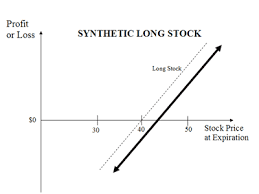
Among the many options strategies, one of the most interesting is synthetic long stock
P/L chart of Synthetic Long Stock:

- Buy 1 ATM Call
- Sell 1 ATM Put
The cost to open the position is close to zero and may even produce a small credit.
A couple of examples, both using closing values on May 31, 2018 and both citing options expiring on June 15, exactly two weeks away:
Walmart (WMT) $82.54
83 call, ask 1.08 = $113
83 put, bid 1.36 = $131
35 call, ask 0.89 = $94
35 put, bid 1.17 = $112
In both examples, the closest to the money strikes were used. Both yielded $18 net credit to open the positions. The differences between strike price and dollar value is estimated as $5 for trading fees.
A period longer than two weeks could have been used as well. Because synthetic long stock involves buying a call and selling a put, longer-term positions do not present the time value problem usually faced by options traders. For example, with the net credit close to zero, the position combines to provide exceptional leverage, control over 100 shares not only for no cost, but for an $18 net credit.
The changes in value will mirror movement in the stock as it moves, point for point. The call’s intrinsic value above its strike is going to be one dollar higher for each point of movement in the stock. If the stock moves downward, the put gains one point for each point lost in the stock; and because the put was short, this represents a loss – in fact, identical to the loss of just owning the stock.
The options are likely to track closer to movement in the stock because time value is going to disappear fast, and extrinsic (volatility) value will be less of a factor in overall premium value as expiration approaches.
Some risk factors to remember:
- The market risk in synthetic long stock is the same as that of owning 100 shares of the stock. However, in this example, owning shares costs $8,200 for WMT, or $3,500 for M, either of which can be bought for 50% on margin; and the short put is subject to margin requirements equal to 20% of the strike values. This means the short put margin cost is lower than the stock purchase cost.
- Losses in the short put are mitigated by closing the position, rolling it forward, or buying a later-expiring long put. Losses in long stock cannot be managed in the same way. Losses have to be taken or waited out.
- Holding the short put represents the primary risk in the position. However, this is the same downside risk as owning 100 shares of stock. The net cost to open the position is close to zero until the collateral requirements are considered. On a practical level, the most likely outcome would be to close the short put once it becomes possible to take profits, and leave the long call to appreciate. This is the best of both worlds: low-cost call with profit potential paid for by a short put position.

The market risk of an uncovered put is identical to the risk of a covered call. Combined with the limited risk of the long call, this makes synthetic long stock a very conservative trade.
Synthetic positions can also be opened on the short side, combining a long put and a short call. This may seem higher-risk than the synthetic long stock; but it can be made more conservative by covering the call. But as long as the call remains uncovered, synthetic short stock is higher-risk than synthetic long.
Synthetics are intriguing and interesting. They provide the possibility to profit from stock price changes, without needing to buy shares of stock. The offsetting cost/income also makes it practical to use long-term options without needing to worry about time decay. This affects both sides equally, meaning there is no net effect of decay during the period the position remains open.
Michael C. Thomsett is a widely published author with over 80 business and investing books, including the best-selling Getting Started in Options, coming out in its 10th edition later this year. He also wrote the recently released The Mathematics of Options. Thomsett is a frequent speaker at trade shows and blogs on his website at Thomsett Guide as well as on Seeking Alpha, LinkedIn, Twitter and Facebook.
What Is SteadyOptions?
Full Trading Plan
Complete Portfolio Approach
Diversified Options Strategies
Exclusive Community Forum
Steady And Consistent Gains
High Quality Education
Risk Management, Portfolio Size
Performance based on real fills
Non-directional Options Strategies
10-15 trade Ideas Per Month
Targets 5-7% Monthly Net Return
Recent Articles
Articles
Pricing Models and Volatility Problems
Most traders are aware of the volatility-related problem with the best-known option pricing model, Black-Scholes. The assumption under this model is that volatility remains constant over the entire remaining life of the option.
By Michael C. Thomsett, August 16

- Added byMichael C. Thomsett
- August 16
Option Arbitrage Risks
Options traders dealing in arbitrage might not appreciate the forms of risk they face. The typical arbitrage position is found in synthetic long or short stock. In these positions, the combined options act exactly like the underlying. This creates the arbitrage.
By Michael C. Thomsett, August 7

- Added byMichael C. Thomsett
- August 7
Why Haven't You Started Investing Yet?
You are probably aware that investment opportunities are great for building wealth. Whether you opt for stocks and shares, precious metals, forex trading, or something else besides, you could afford yourself financial freedom. But if you haven't dipped your toes into the world of investing yet, we have to ask ourselves why.
By Kim, August 7

- Added byKim
- August 7
Historical Drawdowns for Global Equity Portfolios
Globally diversified equity portfolios typically hold thousands of stocks across dozens of countries. This degree of diversification minimizes the risk of a single company, country, or sector. Because of this diversification, investors should be cautious about confusing temporary declines with permanent loss of capital like with single stocks.
By Jesse, August 6

- Added byJesse
- August 6
Types of Volatility
Are most options traders aware of five different types of volatility? Probably not. Most only deal with two types, historical and implied. All five types (historical, implied, future, forecast and seasonal), deserve some explanation and study.
By Michael C. Thomsett, August 1

- Added byMichael C. Thomsett
- August 1
The Performance Gap Between Large Growth and Small Value Stocks
Academic research suggests there are differences in expected returns among stocks over the long-term. Small companies with low fundamental valuations (Small Cap Value) have higher expected returns than big companies with high valuations (Large Cap Growth).
By Jesse, July 21

- Added byJesse
- July 21
How New Traders Can Use Trade Psychology To Succeed
People have been trying to figure out just what makes humans tick for hundreds of years. In some respects, we’ve come a long way, in others, we’ve barely scratched the surface. Like it or not, many industries take advantage of this knowledge to influence our behaviour and buying patterns.

- Added byKim
- July 21
A Reliable Reversal Signal
Options traders struggle constantly with the quest for reliable
By Michael C. Thomsett, July 20

- Added byMichael C. Thomsett
- July 20
Premium at Risk
Should options traders consider “premium at risk” when entering strategies? Most traders focus on calculated maximum profit or loss and breakeven price levels. But inefficiencies in option behavior, especially when close to expiration, make these basic calculations limited in value, and at times misleading.
By Michael C. Thomsett, July 13

- Added byMichael C. Thomsett
- July 13
Diversified Leveraged Anchor Performance
In our continued efforts to improve the Anchor strategy, in April of this year we began tracking a Diversified Leveraged Anchor strategy, under the theory that, over time, a diversified portfolio performs better than an undiversified portfolio in numerous metrics. Not only does overall performance tend to increase, but volatility and drawdowns tend to decrease:
Wednesday, February 21, 2018